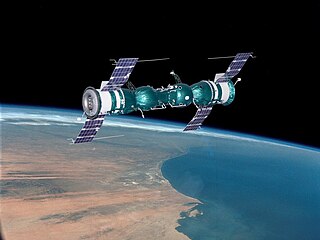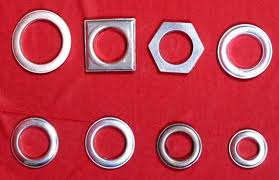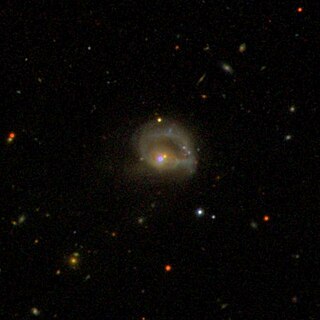
A forge is a type of hearth used for heating metals, or the workplace (smithy) where such a hearth is located. The forge is used by the smith to heat a piece of metal to a temperature at which it becomes easier to shape by forging, or to the point at which work hardening no longer occurs. The metal is transported to and from the forge using tongs, which are also used to hold the workpiece on the smithy's anvil while the smith works it with a hammer. Sometimes, such as when hardening steel or cooling the work so that it may be handled with bare hands, the workpiece is transported to the slack tub, which rapidly cools the workpiece in a large body of water. However, depending on the metal type, it may require an oil quench or a salt brine instead; many metals require more than plain water hardening. The slack tub also provides water to control the fire in the forge.
Mithril is a fictional metal found in the writings of J. R. R. Tolkien, which is present in his Middle-earth, and also appears in many other works of derivative fantasy. It is described as resembling silver but being stronger and lighter than steel. The author first wrote of it in The Lord of the Rings, and it was retrospectively mentioned in the third, revised edition of The Hobbit in 1966. In the first 1937 edition, the mail shirt given to Bilbo Baggins is described as being made of "silvered steel".

Velvet is a type of woven tufted fabric in which the cut threads are evenly distributed, with a short pile, giving it a distinctive soft feel. By extension, the word velvety means "smooth like velvet". In the past, velvet was typically made from silk. Today, velvet can be made from linen, cotton, wool and synthetic fibers.

Soyuz 5 was a Soyuz mission using the Soyuz 7K-OK spacecraft launched by the Soviet Union on 15 January 1969, which docked with Soyuz 4 in orbit. It was the first docking of two crewed spacecraft of any nation, and the first transfer of crew from one space vehicle to another of any nation, the only time a transfer was accomplished with a space walk – two months before the United States Apollo 9 mission performed the first internal crew transfer.

In the United States, Canada and the United Kingdom, grips are camera support equipment technicians in the filmmaking and video production industries. They constitute their own department on a film set and are directed by a key grip. Grips have two main functions: The first is to work closely with the camera department to provide camera support, especially if the camera is mounted to a dolly, crane, or in an unusual position, such as the top of a ladder. Some grips may specialize in operating camera dollies or camera cranes. The second function is to work closely with the electrical department to create lighting set-ups necessary for a shot under the direction of the director of photography.
Grips' responsibility is to build and maintain all the equipment that supports cameras. This equipment, which includes tripods, dollies, tracks, jibs, cranes, and static rigs, is constructed of delicate yet heavy duty parts requiring a high level of experience to operate and move. Every scene in a feature film is shot using one or more cameras, each mounted on highly complex, extremely expensive, heavy duty equipment. Grips assemble this equipment according to meticulous specifications and push, pull, mount or hang it from a variety of settings. The equipment can be as basic as a tripod standing on a studio floor, to hazardous operations such as mounting a camera on a 100 ft crane, or hanging it from a helicopter swooping above a mountain range.
Good Grips perform a crucial role in ensuring that the artifice of film is maintained, and that camera moves are as seamless as possible. Grips are usually requested by the DoP or the camera operator. Although the work is physically demanding and the hours are long, the work can be very rewarding. Many Grips work on both commercials and features.

A grommet is a ring or edge strip inserted into a hole through thin material, typically a sheet of textile fabric, sheet metal or composite of carbon fiber, wood or honeycomb. Grommets are generally flared or collared on each side to keep them in place, and are often made of metal, plastic, or rubber. They may be used to prevent tearing or abrasion of the pierced material or protection from abrasion of the insulation on the wire, cable, line being routed through the penetration, and to cover sharp edges of the piercing, or all of the above.

A chandelier is a branched ornamental light fixture designed to be mounted on ceilings or walls. Chandeliers are often ornate, and normally use incandescent light bulbs, though some modern designs also use fluorescent lamps and recently LEDs.

An X-ray microscope uses electromagnetic radiation in the soft X-ray band to produce magnified images of objects. Since X-rays penetrate most objects, there is no need to specially prepare them for X-ray microscopy observations.

A soft box is a type of photographic lighting device, one of a number of photographic soft light devices. All the various soft light types create even and diffused light by transmitting light through some scattering material, or by reflecting light off a second surface to diffuse the light. The best known form of reflective source is the umbrella light, where the light from the bulb is "bounced" off the inside of a metalized umbrella to create an indirect "soft" light.

Ellipsoidal reflector spot is the name for a type of stage lighting instrument, named for the ellipsoidal reflector used to collect and direct the light through a barrel that contains a lens or lens train. The optics of an ERS instrument are roughly similar to those of a 35 mm slide projector. There are many types of ERS that are designed for the myriad applications found in the entertainment industry. ERS instruments come in all shapes and sizes. Each particular model of ERS has its own set of characteristics. Generally, ERS instruments are the most varied and utilized type of stage lighting instrument. ERS may also be referred to as Profile Spotlights because the beam can be shaped to the profile of an object. Ellipsoidal reflectors are used for their strong, well-defined light and their versatility. Leko and Source Four are brand names which are often, but inaccurately, used to refer to any sort of ellipsoidal.

The Stanford Synchrotron Radiation Lightsource, a division of SLAC National Accelerator Laboratory, is operated by Stanford University for the Department of Energy. SSRL is a National User Facility which provides synchrotron radiation, a name given to electromagnetic radiation in the x-ray, ultraviolet, visible and infrared realms produced by electrons circulating in a storage ring at nearly the speed of light. The extremely bright light that is produced can be used to investigate various forms of matter ranging from objects of atomic and molecular size to man-made materials with unusual properties. The obtained information and knowledge is of great value to society, with impact in areas such as the environment, future technologies, health, biology, basic research, and education.

A Fresnel lantern is a common lantern used in theatre that employs a Fresnel lens to wash light over an area of the stage. The lens produces a wider, soft-edged beam of light, which is commonly used for back light and top light.

The Advanced Light Source (ALS) is a research facility at Lawrence Berkeley National Laboratory in Berkeley, California. One of the world's brightest sources of ultraviolet and soft x-ray light, the ALS is the first "third-generation" synchrotron light source in its energy range, providing multiple extremely bright sources of intense and coherent short-wavelength light for use in scientific experiments by researchers from around the world. It is funded by the US Department of Energy (DOE) and operated by the University of California. In June 2018, Stephen Kevan became the director of the ALS.
ANSTO's Australian Synchrotron is a 3 GeV national synchrotron radiation facility located in Clayton, in the south-eastern suburbs of Melbourne, Victoria, which opened in 2007.

Portrait photography, or portraiture, is a type of photography aimed toward capturing the personality of a person or group of people by using effective lighting, backdrops, and poses. A portrait photograph may be artistic or clinical. Frequently, portraits are commissioned for special occasions, such as weddings, school events, or commercial purposes. Portraits can serve many purposes, ranging from usage on a personal web site to display in the lobby of a business.
Horse harness is a device that connects a horse to a vehicle or another type of load.
Stage lighting accessories are components manufactured for conventional (non-automated) stage lighting instruments. Most conventional fixtures are designed to accept a number of different accessories designed to assist in the modification of the output. These accessories are intended to either provide relatively common functionality not originally provided in a fixture, or to extend the versatility of a lighting instrument by introducing features. Other accessories have been designed to overcome limitations or difficulties some fixtures present in specific applications.

The National Synchrotron Light Source II (NSLS-II) at Brookhaven National Laboratory (BNL) in Upton, New York is a national user research facility funded primarily by the U.S. Department of Energy's (DOE) Office of Science. NSLS-II is one of the world's most advanced synchrotron light sources, designed to produce x-rays 10,000 times brighter than BNL's original light source, the National Synchrotron Light Source (NSLS). NSLS-II supports basic and applied research in energy security, advanced materials synthesis and manufacturing, environment, and human health.

A dive light is a light source carried by an underwater diver to illuminate the underwater environment. Scuba divers generally carry self-contained lights, but surface supplied divers may carry lights powered by cable supply.

NGC 985 is a ring galaxy in the constellation of Cetus. It is located about 550 million light years away from Earth, which means, given its apparent dimensions, that NGC 985 is approximately 160,000 light years across. It was discovered by Francis Leavenworth in 1886. It is a type 1 Seyfert galaxy.















